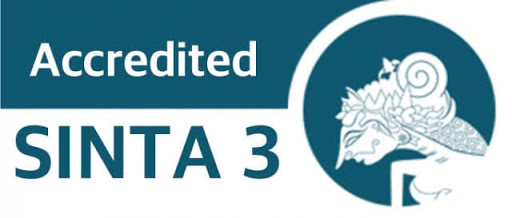DEVELOPING WEB-BASED TEACHING MATERIALS ON THE SUBJECT OF SCHOOL CURRICULUM DEVELOPMENT
Abstract
The development of science and technology has changed the elements in all fields, especially education. The learning patterns have also changed; one of which is using computer-based or internet / web-based learning, such as: E-learning, online courses, web-based education, and others. This paradigm shift sometimes requires lecturers to be more creative in delivering learning materials to students, especially, in this research, in the subject of school curriculum development. This aims to increase the effectiveness and flexibility of learning. In its implementation, the school curriculum development subject still ituilize printed teaching materials during the learning process. The purpose of this research was to develop web-based teaching materials for the subject of school curriculum development. This research applied research and development method with ADDIE model (Analysis, Design, Development, Implementation, and Evaluation). The development of web-based teaching materials in this research was assessed through the expert review stage with an accumulation of assessment results from media experts, design experts, linguists, and media experts. The result showed that the percentage of the expert review was 86% very good category. Then, the percentage of the individual test (one to one) was 85% with very good category. After that, the percentage of small group test was 85% with very good category. Based on these results, it can be concluded that web-based teaching materials are feasible to be applied to in the subject of school curriculum development.
Keywords
Full Text:
PDF (Bahasa Indonesia)References
Arikunto, S. (2010). Prosedur Penelitian Suatu Pendekatan Praktik. Jakarta: Rineka Cipta
Branch, R. M. (2009). Instructional Design-The ADDIE Approach. New York: Springer.
Chang, K., Sung Y.T., & Hou, H.T. (2006). Web-based Tools for Designing and Developing Teaching Materials for Integration of Information Technology into Instruction. Educational Technology & Society, 9 (4), 139-149.
Cholid, A. A., Elmunsyah, H., & Patmanthara. (2016). Pengembangan Model Web Based Learning Pada Mata Pelajaran Jaringan Dasar Paket Keahlian Tkj Pada Smkn Se-Kota Malang. Jurnal Pendidikan: Teori, Penelitian, dan Pengembangan Volume: 1 Nomor: 5
Firmansyah, R., Saidah, I,. (2016). Perancangan Web Based Learning Sebagai Media Pembelajaran. INFORMATIKA Vol. 3, 176 – 182
Hamid, S. (2012). Mendesain Kegiatan Belajar-Mengajar Begitu Menghibur, Metode Edutainment Menjadikan Siswa Kreatif dan Nyaman di Kelas. Yogyakarta: Divapress.
Huang, H. M. (2002). Toward constructivism for adult learners in online learning environments. British Journal of Educational Technology 33(1): 27:’37
Nordin, A. B. (2008). Web-Based Teaching And Learning Approach ( WBTLA ) Usability In Institutions Of Higher Learning. The Malaysian Online Journal of Educational Technology, Vol 1 Issue 2
Panen, P,. Purwanto. (2001). Penulisan Bahan Ajar. Jakarta: PAU-PPAI, Universitas Terbuka.
Parumbuan, M.D. (2016). Pengembangan Bahan Ajar Berbasis Web untuk Mata Kuliah Desain Pesan. Jurnal Inovasi dan Teknologi Pembelajaran, Volume 1, Nomor 4 April 2016
Pebriantika, L., Negara, A.P,. (2018). Pengembangan Bahan Ajar Berbasis Web Mata Pelajaran Biologi Kelas XI. Baturaja Journal of Educational Technology ,Vol 2 No 2.
Pebriantika, L., Paristiowati, M., & Mochtar, H. (2019). Students ’ Perceptions of Mobile Technology in Higher Education: Preparation to Design Mobile Learning Models. Universal Journal of Educational Research, 7, 180–185.
Prastowo, A. (2011). Panduan Kreatif Membuat Bahan Ajar Inovatif; Menciptakan Metode Pembelajaran yang Menarik dan Menyenangkan. Jogjakarta: DIVA Pers.
Purmadi, A., Surjono. (2016). Pengembangan Bahan Ajar Berbasis Web Berdasarkan Gaya Belajar Siswa untuk Mata Pelajaran Fisika. Jurnal Inovasi Teknologi Pendidikan Volume 3, No 2
Rahayu, K. P. (2018). Pengaruh Web Based Learning Terhadap Hasil Belajar Ditinjau Dari Self-Directed Learning. Jurnal SAP Vol. 2 No. 3
Sugiyono. (2010). Metode Penelitian Pendidikan; Pendekatan Kuantitatif, Kualitatif, dan R & D. Bandung: Alfabeta.
Sulthon. (2013). Peningkatan Kualitas Pembelajaran Melalui Pendekatan Konstruktivistik dalam Pendidikan Bagi Anak Usia Dini. Jurnal Inovasi Pendidikan Guru Raudhatul Athfal, Volume 1, Nomor 1
Suparman, A. (2012). Desain Instruksional Modern. Jakarta : Erlangga.
Suprijanto. (2008). Pendidikan Orang Dewasa; dari Teori Hingga Aplikasi. Jakarta: Bumi Aksara
Wasim, J., Sharma, S. K., Khan, I. A., & Siddiqui, J. (2014). Web Based Learning. International Journal of Computer Science and Information Technologies (IJCSIT), Vol. 5 (1)
Wijaya, J. E., Vidianti, A., & Pebriantika, L. (2019). Needs analysis for the development of E-moduls at teaching materials. Asian Proceedings of social sciences 4 (3)
DOI: http://dx.doi.org/10.33578/pjr.v4i6.8183
Refbacks
- There are currently no refbacks.
Copyright (c) 2020 JURNAL PAJAR (Pendidikan dan Pengajaran)

This work is licensed under a Creative Commons Attribution-NonCommercial-ShareAlike 4.0 International License.
JURNAL PAJAR (Pendidikan dan Pengajaran)
Secretariat
Program Studi Pendidikan Guru Sekolah Dasar
Gedung B1, FKIP Universitas Riau
Kampus Bina Widya Km. 12,5 Simpang Baru Panam
Pekanbaru Riau Indonesia 28293
e-mail : pajar@ejournal.unri.ac.id



